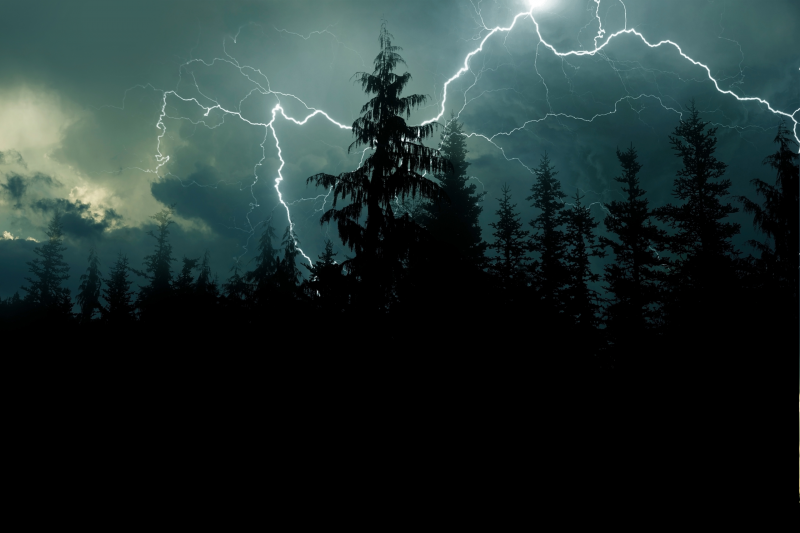When Lightning Strikes on the Trail
Weather happens, and while it can oftentimes be unexpected the best thing you can be is prepared. We teamed up with GOES Health App to help you learn more about what to do when a storm is rolling in and lightning is lighting up the sky while you're on the trail.

Picture this...
It’s July. You're a mile away from your campsite. When you checked the forecast, it was supposed to be a perfectly sunny day. But you didn’t account for the summer microclimates that happen in high altitudes. You find yourself in the middle of a sudden lightning storm and don’t remember what to do or where to go. Far out of service, you couldn’t look up what you should do. (Are you supposed to find a tall tree? Or stay away from it? Go into an open field? Or find cover? In that moment, you are confronted how little you actually know about lightning safety.)
Knowledge is power
Having a basic understanding of what lightning and thunder are can help you make sense of how lightning behaves.
Static electricity builds up in storm clouds until it reaches a breaking point and needs to get released. The charged molecules from the sky need to meet the oppositely charged particles of the ground. This electrical release results in a 270,000 mph, 30-million-volt bolt of lightning that we see.
The speed and energy in this bolt of lightning emits incredible amounts of heat (up to 50,000ºF). This immense amount of instantaneous heat supercharges the air molecules around the strike. The rapid expansion and cooling of these molecules create the rippling sound wave of thunder that you can hear up to ten miles away.
Since light travels quicker than sound, you’ll usually see lightning first, then hear its associated thunder.

The 30-30 Rule
The “30-30 Rule” utilizes this relationship between lightning and thunder. Use it to gauge how close you are to lightning.
- See a flash of lightning? Start counting the seconds. Each second of silence is roughly equivalent to one mile of distance from you and the lightning.
- If you hear a clap of thunder within 30 seconds of seeing lightning, it means lightning is near and within striking distance. (The louder and sharper the thunder, the closer you are to the lightning.) Seek shelter immediately.
- Remain sheltered for 30 minutes from the last strike.
Safest Shelters
Not all shelters are created equal. These are some of the safer places you could take shelter in during a lightning storm:
- Go indoors: Sealed structures that will insulate and protect you from the elements.
- Parked and closed cars: Similar protection to being indoors. (However, convertibles or golf carts that are not closed leave you vulnerable to lightning.)
- Thick forest or deep valley: Thick forest canopies serve as a buffer and dissipate the energy from the blast point. Deep valleys are physically farther away from the storm clouds; the charge in the storm will be attracted to higher points that are closer to the charged particles.
- Deep cave: Make sure the cave is deeper than it is tall. Avoid a cave that is tall and shallow, which can invite a lightning strike.

Top-of-mind tips
If you find yourself outdoors without access to shelter during a thunderstorm, keep these 3 tips in mind:
1. Go Low
Get to lower elevation. Lightning is attracted to the tallest points at the highest elevations. If there is nowhere to go and it is unsafe to descend, look out for deep caves, ditches, divots or any other low points. Distance yourself from tall, isolated objects as they are the most likely targets for the impending strike.
2. Avoid Effective Conductors
If you find yourself in striking distance of a storm, avoid conductors such as water and metal. Beware of the poles in your tent as they likely contain metal, making your tent a potentially unsafe option when seeking shelter.
3. Lightning Crouch
If you’re in an open and exposed area, distance yourself from all other objects and crouch low on the balls of your feet with your head down. The smaller you can make yourself in an open space, the better. If you’re with a group of people, it’s best for each person to stay about 20 feet apart from one another.
Struck by lightning
Getting struck by lightning is a severe injury, but can vary dramatically. (About 10% of lightning strikes are fatal.) A lightning strike can cause severe nerve, muscular, bone and organ damage, not to mention short circuiting of the heart and the brain. While the heart will usually restart shortly after on its own, it takes longer for your brain to follow suit. If a person is not breathing, it may be necessary to perform CPR. And just because a person seems fine, it doesn’t mean they are fine. Anyone struck by lightning should be taken to a medical professional immediately.
GOES goes with you
Don’t get caught not knowing what to do. Unexpected things happen all the time outdoors. GOES has everything you need to know about lightning, and more, including a library of 60+ topics, offline protocols and how-to guides to help you figure out what’s wrong and know what to do. All of this was built by wilderness medicine experts and is always just a few taps away, and always available offline, no matter how remote you are.
Download the GOES Health app today and enter AHS10OFF for 10% off a premium GOES+ subscription to access valuable information from wilderness medicine experts. Enhance your outdoor experience by staying informed about weather risks and learning crucial tips for your well-being.
